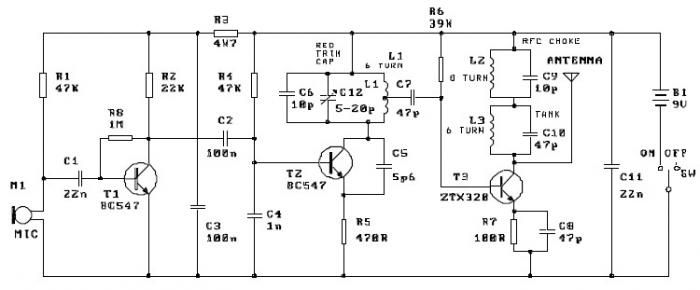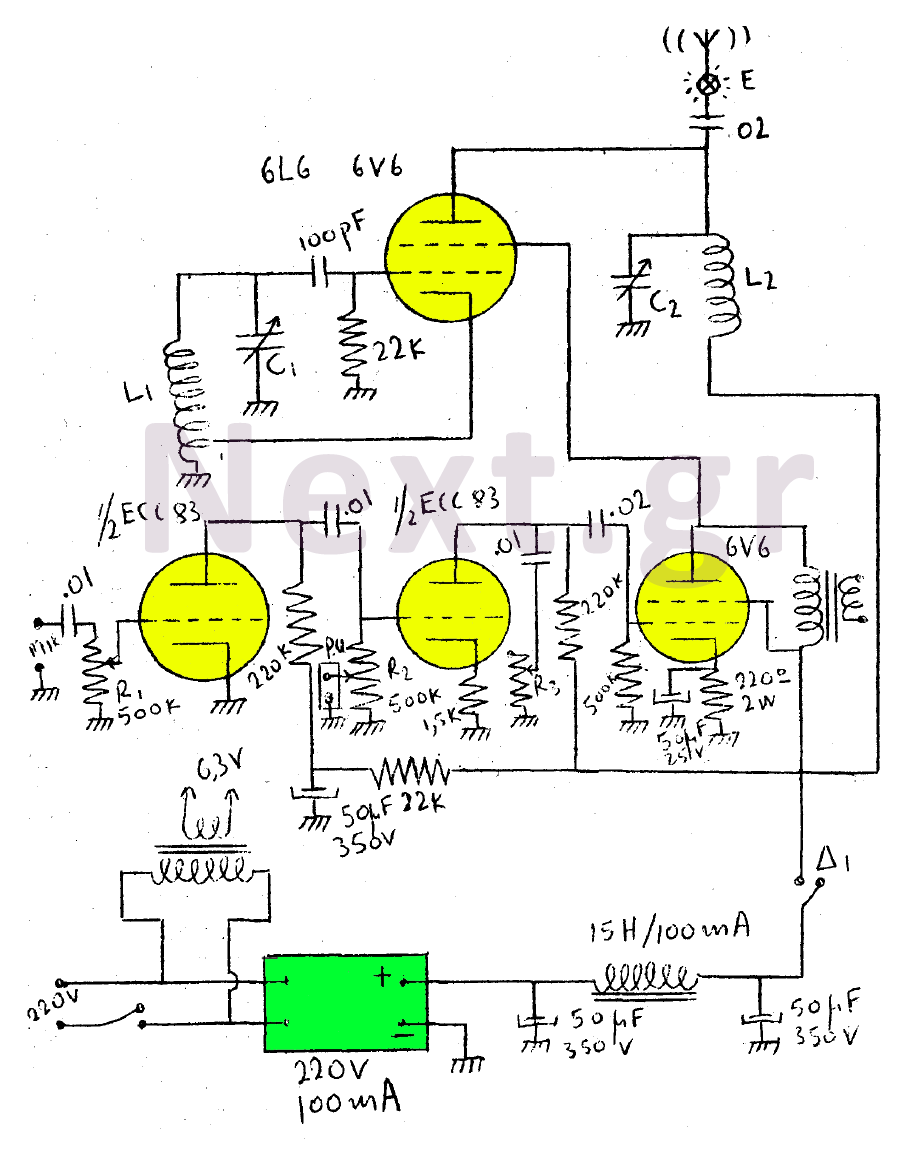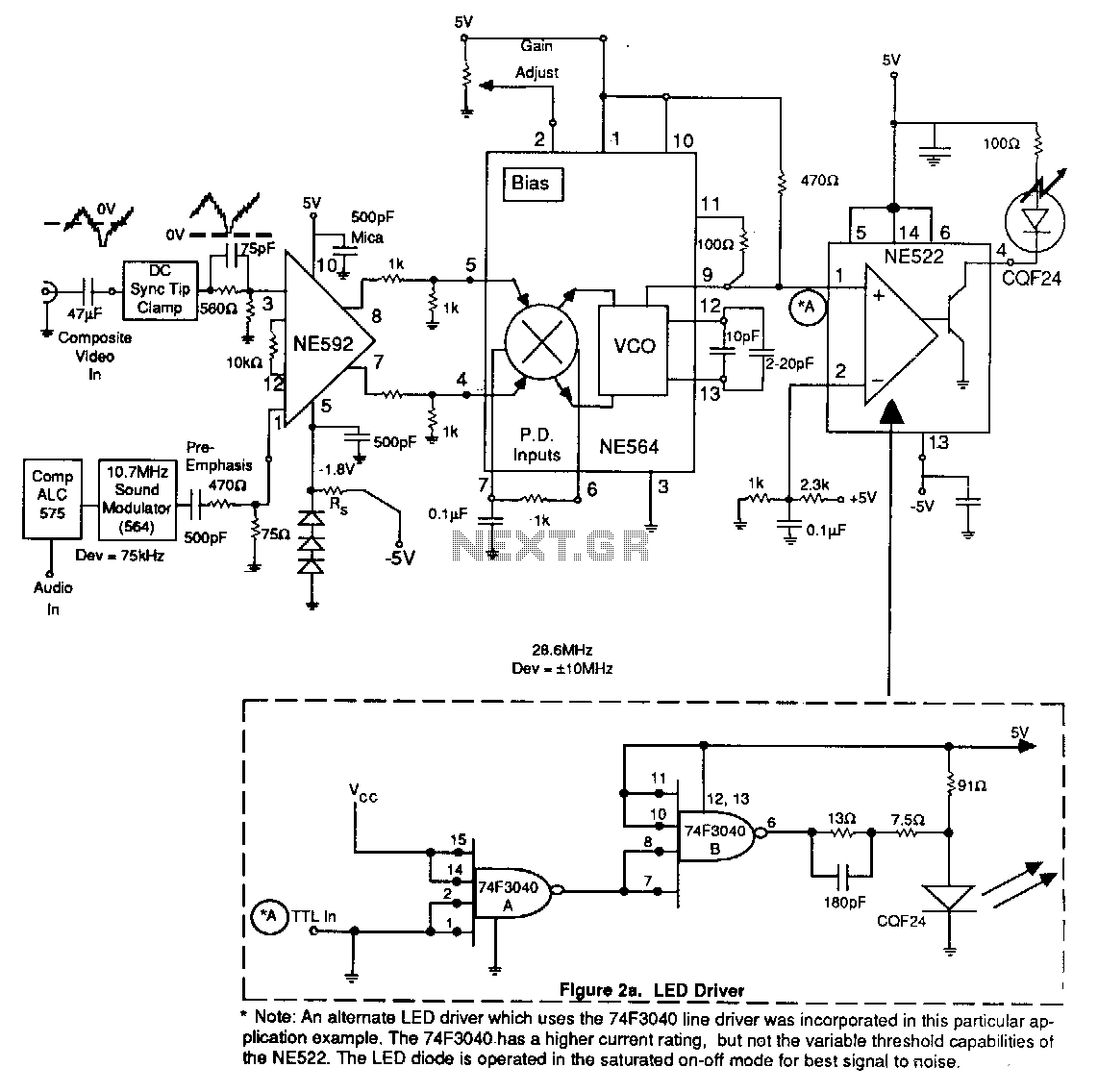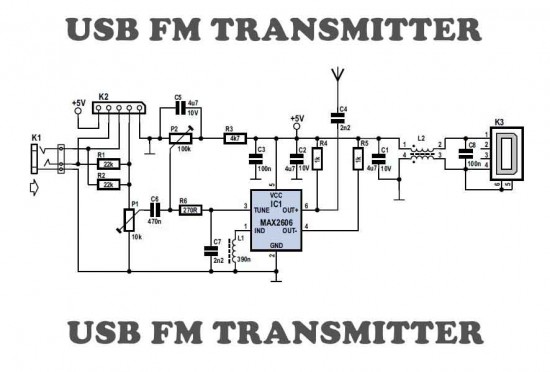
Wireless Stereo FM Transmitter BA1404
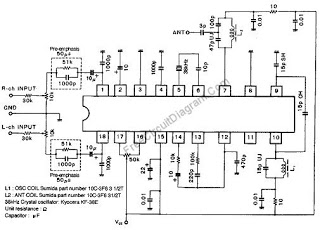
This wireless stereo FM transmitter is constructed using a monolithic integrated circuit (IC). The internal architecture of this FM transmitter IC includes a stereo modulator that generates a stereo composite signal, an FM modulator that modulates a carrier frequency with the composite signal, and an RF amplifier that provides sufficient power for transmission through an antenna. The primary component of this stereo FM transmitter is the BA1404 integrated circuit chip from ROHM. This FM transmitter is well-suited for use with wireless microphones or as an audio interface for home or car audio systems. For instance, it allows playback of audio from a portable MP3 or MP4 player on older car radio systems that lack a line input. The stereo FM transmitter chip is designed to operate within the 75-108 MHz FM band, and users can adjust its operation by fine-tuning the LC network connected to pin 10 of the IC. To facilitate this adjustment, a variable capacitor in the range of 22-33 pF can be employed in place of the 15 pF capacitor connected to pin 10. This stereo FM transmitter operates with a power supply of only 1.5-3V, making it suitable for battery-powered applications. Exceeding a supply voltage of 3.5V may damage the FM transmitter circuit.
This wireless stereo FM transmitter utilizes the BA1404 integrated circuit, which integrates multiple functionalities essential for FM transmission. The stereo modulator within the IC combines two audio channels into a single stereo composite signal, which is then fed into the FM modulator. This modulator alters the carrier frequency according to the composite signal, effectively encoding the audio information onto the RF signal. The RF amplifier boosts the modulated signal, enabling it to be transmitted over the airwaves through an antenna.
The transmitter is designed to operate within the FM broadcasting band of 75-108 MHz. This frequency range is suitable for short-range audio transmission, making the device ideal for applications such as wireless audio streaming from a personal device to an older radio system. The ability to connect to various audio sources, including MP3 and MP4 players, enhances its versatility.
For optimal performance, the operational frequency can be fine-tuned by adjusting the LC network connected to pin 10 of the BA1404 IC. A variable capacitor between 22-33 pF can replace the fixed 15 pF capacitor, allowing users to achieve the desired frequency response for their specific application. This feature is particularly useful for ensuring clear audio transmission and minimizing interference from other radio sources.
Power consumption is kept low, with the device requiring only a 1.5-3V power supply. This low-voltage requirement makes the transmitter particularly suitable for portable applications, as it can be easily powered by batteries. It is critical to adhere to the recommended voltage limits, as exceeding 3.5V could lead to circuit failure. Overall, the design of this wireless stereo FM transmitter provides an effective solution for audio transmission in various settings, combining ease of use with reliable performance.This Wireless Stereo FM Transmitter built from a monolithic IC. The internal structure of this FM transmitter integrated circuit consist of stereo modulator that creates a stereo composite signal, an FM modulator that modulate a carrier frequency with the composite signal, and an RF amplifier that provide enough power to be transmitted through ant enna. The core of this stereo FM transmitter is BA1404 integrated circuit chip. from ROHM. This FM transmitter is ideal for wireless microphone, or for audio interface and distribution for home or car appliance. For example, you can now play your portable mp3/mp4 player on your old car radio sound system that doesn`t have line-input plug.
This stereo FM transmitter chip is designed for 75-108 FM band, and you can adjust the operation by trimming the LC network connected to pin 10 of this IC chip. To ease the adjustment, you can use a 22-33p variable capacitor for the 15p capacitor connected to pin 10.
Finally, this stereo FM transmitter works with only 1. 5-3V power supply, ideal for battery operation. More than 3. 5V supply voltage could burn this FM transmitter circuit. 🔗 External reference
This wireless stereo FM transmitter utilizes the BA1404 integrated circuit, which integrates multiple functionalities essential for FM transmission. The stereo modulator within the IC combines two audio channels into a single stereo composite signal, which is then fed into the FM modulator. This modulator alters the carrier frequency according to the composite signal, effectively encoding the audio information onto the RF signal. The RF amplifier boosts the modulated signal, enabling it to be transmitted over the airwaves through an antenna.
The transmitter is designed to operate within the FM broadcasting band of 75-108 MHz. This frequency range is suitable for short-range audio transmission, making the device ideal for applications such as wireless audio streaming from a personal device to an older radio system. The ability to connect to various audio sources, including MP3 and MP4 players, enhances its versatility.
For optimal performance, the operational frequency can be fine-tuned by adjusting the LC network connected to pin 10 of the BA1404 IC. A variable capacitor between 22-33 pF can replace the fixed 15 pF capacitor, allowing users to achieve the desired frequency response for their specific application. This feature is particularly useful for ensuring clear audio transmission and minimizing interference from other radio sources.
Power consumption is kept low, with the device requiring only a 1.5-3V power supply. This low-voltage requirement makes the transmitter particularly suitable for portable applications, as it can be easily powered by batteries. It is critical to adhere to the recommended voltage limits, as exceeding 3.5V could lead to circuit failure. Overall, the design of this wireless stereo FM transmitter provides an effective solution for audio transmission in various settings, combining ease of use with reliable performance.This Wireless Stereo FM Transmitter built from a monolithic IC. The internal structure of this FM transmitter integrated circuit consist of stereo modulator that creates a stereo composite signal, an FM modulator that modulate a carrier frequency with the composite signal, and an RF amplifier that provide enough power to be transmitted through ant enna. The core of this stereo FM transmitter is BA1404 integrated circuit chip. from ROHM. This FM transmitter is ideal for wireless microphone, or for audio interface and distribution for home or car appliance. For example, you can now play your portable mp3/mp4 player on your old car radio sound system that doesn`t have line-input plug.
This stereo FM transmitter chip is designed for 75-108 FM band, and you can adjust the operation by trimming the LC network connected to pin 10 of this IC chip. To ease the adjustment, you can use a 22-33p variable capacitor for the 15p capacitor connected to pin 10.
Finally, this stereo FM transmitter works with only 1. 5-3V power supply, ideal for battery operation. More than 3. 5V supply voltage could burn this FM transmitter circuit. 🔗 External reference

